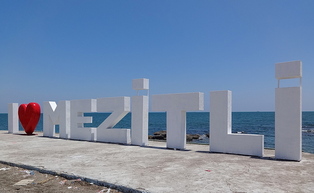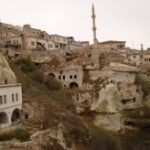“Ruined City”
Old name: Soli (Greek), Pompeiopolis (Roman)
The original settlement of what is now Mersin at Yumuktepe appears to date back to Neolithic times but there was also a major development east of the centre in what is now the suburb of Mezitli.
The journey to Mezitli from the centre of Mersin is not one to raise the spirits since the coast road skims an unbroken wall of high-rise apartment blocks and shopping complexes. Finally, the bus turns left and heads down towards the sea and the site of what is now called Viranşehir.
Backstory
Viranşehir was originally the port city of Soli which appears to have been settled by colonists from Rhodes c. 700 BC.
Once a large and important place, it became the capital of a Persian province, before succumbing first to the Athenians, then to Alexander the Great, and finally to the Commagenian King Antiochus III. Then in 91 BC its population was driven out and resettled in Eastern Anatolia.
Soli recovered its former importance with the arrival of the Roman General Pompey who used it as a base for suppressing the pirates who preyed on local shipping. Renamed Pompeiopolis, it acquired new walls, new roads and all sorts of important civic buildings, and when the Persians came calling again in 260 the local population was strong enough to send them packing.
But then nature took its toll. In 527 Pompeiopolos was flattened by an earthquake from which it was never able to recover. Now much of the site lies buried beneath Mezitli.
Note that this site should be confused with the town of Viranşehir, near Urfa, or Viranşehir, the ruined site on the slopes of Mt Hasan in Cappadocia.
The site
Today there’s almost nothing left to suggest how important Viranşehir once was – just a single line of 2nd-century columns that once marched alongside the main road leading from the northern gate to the harbour. Of the 41 columns still standing, 33 retain their capitals; the most southerly also retain brackets which would have supported statues of the emperors and important local dignitaries.
Sadly the columns are inaccessible behind a wire fence. Ditto with a few pieces of stone and marble preserved on the opposite side of the road.
It’s worth walking down to the sea where the car park stands right over the site of the old warehouses and other buildings that would once have served a harbour created during the reigns of the Emperors Hadrian (r. 117-38) and Antoninus Pius (r.138-61). In the water you’ll see a few slabs of stone that must once have formed part of the harbour wall.
As you return to the bus stop you might eye a surprising empty plot of land to the left of the road. This was probably the site of the agora.
Transport info
Buses leave for Viranşehir from more or less in front of the Atatürk Evi in Mersin town centre – catch the same bus back or risk a tedious detour round the suburbs on other services.


